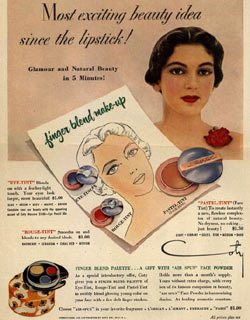talking history | syllabi | students | teachers | puzzle | about us
Ad*Access
http://scriptorium.lib.duke.edu/adaccess/.
Created by the Digital Scriptorium, Duke University, in 1997–1998.
Reviewed March 15–30, 2001.
What kinds of illustrations, messages, and promotions did advertisers develop in the 1910s and 1920s? How had they changed by the 1950s? What images did marketers use to advertise radio tubes or to convince consumers that cosmetics were acceptable? Answering those questions with traditional research would require extensive time and labor—combing through stacks of magazines and newspapers to identify relevant advertisements before synthesizing and analyzing trends. Ad*Access makes some of this research possible online by presenting more than 7,000 advertisements printed primarily in the United States from 1911 to 1955 in a way that allows students and researchers to investigate consumer culture virtually.
This well-designed, accessible archive draws on advertising clippings from popular magazines and newspapers collected by the J. Walter Thompson Company in order to study competitors. While displaying only a portion of the collection and an even smaller fraction of print advertisements from this era, Ad*Access covers five popular subjects in depth, allowing visitors to study specific campaigns as well as change over time. This site does not claim to be representative and is clearly limited by the original intent of the collectors, emphasizing products and brands that mirrored their client base. Nonetheless, the online materials provide a starting point for studying the five selected categories: “Radio” (including, for example, radios, parts, and programs); “Television” (television sets and programs); “Transportation” (airlines, rental cars, and ships); “Beauty and Hygiene” (cosmetics, feminine hygiene, and shaving supplies); and “World War II” (anti-inflation campaigns, V-mail, and bond drives).
Image quality is good, often preserving original color. Most records include a thumbnail sketch with descriptive information, a full-page copy (72 dpi, dots per inch), and an enlarged version (150 dpi). These options allow the reader to see images as a whole and to read text and view images clearly. Images can be downloaded and printed fairly easily. One technical drawback: images do not work with Internet Explorer 5 (IE5) for the Macintosh, so some users will have to download Netscape or use an earlier version of IE.
A “browse” page allows viewers to explore categories thematically and chronologically. The “Transportation” browse page, for example, divides more than 2,500 advertisements into manageable segments, such as “Airlines: 1938–1942” or “Rental Cars: 1947–1954.” Brief (500–1000-word) histories, written by undergraduates, introduce the categories and provide simplistic overviews of each category useful to students or those new to the subject. Ads are also searchable by keyword, date, company, product, and name of publication, as well as by special features (such as “Drawing in Illustration,” "African Americans,“ and ”Premiums"). The search feature, however, does not allow for searching on multiple items simultaneously, such as children and Palmolive soap.
A few things would enhance Ad*Access. Ads are currently listed by name of publication and year, but dates and page numbers would make it easier for researchers to contextualize ads and analyze placement. Some of this information is available at the library. In addition, there are no tools for teaching students how to read, interpret, and analyze advertisements and images. Advertisements are complex texts, and students new to the genre might benefit from tips or guidelines. Overall, however, this is an excellent archive of primary documents for teachers, researchers, and students of consumer and popular culture.
Kelly Schrum
George Mason University
Fairfax, Virginia

